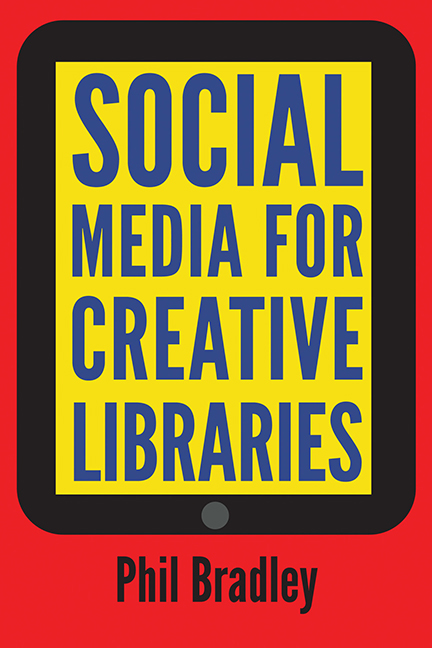Book contents
- Frontmatter
- Contents
- List of figures
- Preface
- 1 An introduction to social media
- 2 Authority checking
- 3 Guiding tools
- 4 Current awareness and selective dissemination of information resources
- 5 Presentation tools
- 6 Teaching and training
- 7 Communication
- 8 Marketing and promotion – the groundwork
- 9 Marketing and promotion – the practicalities
- 10 Creating a social media policy
- Appendix: Social media disasters
- Index
- Frontmatter
- Contents
- List of figures
- Preface
- 1 An introduction to social media
- 2 Authority checking
- 3 Guiding tools
- 4 Current awareness and selective dissemination of information resources
- 5 Presentation tools
- 6 Teaching and training
- 7 Communication
- 8 Marketing and promotion – the groundwork
- 9 Marketing and promotion – the practicalities
- 10 Creating a social media policy
- Appendix: Social media disasters
- Index
Summary
Introduction
In ‘the old days’ people had physically to come into the library to get the information that they needed. Since we were working in a situation when the content and the artefact were inextricably linked, this is not surprising. However, with the advent of CD-ROM networking technology it became much easier for librarians to put information directly onto the desks of the people who needed to use it. Our role then needed to include much more training, because we couldn't see what people were doing – in the library, if they made an error, it was much easier for them just to ask us, or we could see they were having difficulties. However, if the CEO at her desk was trying to find something and couldn’t, she might be less inclined to view the benefits of these technologies favourably. Consequently, the process of moving information out of the library and onto desktops was linked to various activities – not just making it easier to find information, but to teach people how to use the materials (hardware and software) and also to promote and strengthen the value of the library service.
Little changed in the interim, except perhaps ‘more’ – more information, more people and more to promote to a wider audience. We can't expect people to come into the library any longer – we have to go out to them, and remember that ‘Outside the library is still the library’, as Stephen Abram has put it (www.slideshare.net/stephenabram1/fort-bend-tx-may-2013-staffday). In other words, we need to go to where the conversations are; we cannot expect them to come to us. Therefore we need to look at the different types of communication that we want to have with our members and then decide where they can best take place, identify the tools and then get involved. In this chapter we’ll look at what we want to say, who we want to say it to, how we want to say it and when we want to say it.
‘Just the facts’
There are plenty of times when all that you need to do is to communicate one way to tell your members something, and there's little discussion to be had about it. For example, your physical address, your website address, contact details, opening hours and so on.
- Type
- Chapter
- Information
- Social Media for Creative Libraries , pp. 85 - 110Publisher: FacetPrint publication year: 2015



